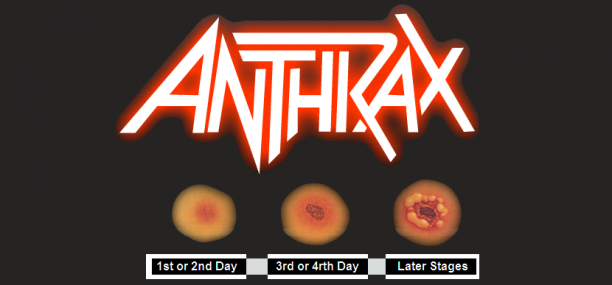ANTHRAX (Сибирская Язва)
Anthrax is an infectious disease caused by bacteria genus Bacillus anthracis, characterized by a number of dermatological signs presenting mainly in the cutaneous form and systemic symptoms especially in the septic form, which can be lethal if not treated properly.
Classification |
|
| Localized form – Cutaneous anthrax | Generalized (septicaemic) Form – Septic anthrax |
Malignant:
|
1. Pulmonary anthrax
2. Gastrointestinal anthrax 3. Anthrax septicaemia 4. Other forms of anthrax
5. Anthrax, unspecified |
Pathogen – Bacillus Anthracis
Epidemiology
The source of infection – sick pets
Mechanism of transmission – by means of contact (commonly), aerogenic, Alimentary (nutritional), Transmissive (from a bite or scratch of infected animals).
Clinical picture
The incubation period ranges between 2 and 14 days.
Cutaneous anthrax
Start gradually.
Carbuncle Form – the consistent development of stains, papules, vesicles, ulcers with dark brown bottom, raised edges and serous-hemorrhagic discharge. Furthermore, secondary “daughter” vesicle(s) may appear on the edges of ulcer(s).
Tissue edema arising on the periphery of a carbuncle is characteristic. However, when triggered a gelatinous shake is observed in it (Stefano symptom).
Regionally increased lymph nodes
Edematous form – the emergence and development of edema, usually followed by subsequent secondary necrosis and small carbuncle.
Bullous form – the formation of bubbles with hemorrhagic fluid, which is formed at the opening of the ulcer.
Erysipeloid form – the emergence of a large number of bubbles with a clear liquid, which remain after the opening ulcers.
The differential diagnosis is carried out with boils, carbuncles, erysipelas, erysipeloid, plague, and tularemia.
Septic anthrax
Develops as a secondary process due to the progression of Cutaneous anthrax (with inadequate therapy and the presence of concomitant adverse factors) or as a result of an aerogenic infection (rag-pickers disease, болезнь тряпичников).
Expressed intoxication syndrome: fever (subfebrile) reaching 39 – 40 ° C, chills.
Pneumonic syndrome: The physical and radiographic evidence of pneumonia and pleurisy.
Involvement of the gastrointestinal tract: Cutting pains in the abdomen, nausea, vomiting blood, bloody diarrhea, intestinal paresis, peritonitis.
Complications: toxic shock, meningoencephalitis, hemorrhagic pulmonary edema, gastrointestinal bleeding.
The differential diagnosis is carried out with plague, tularemia, and sepsis.
Diagnosis
Diagnosis: mainly based on the clinical and epidemiological picture.
Laboratory – bacterioscopic and bacteriological methods.
Serological methods are not standardized.
Skin testing for anthrax
A sample of fluid is taken from a suspicious dermal lesion and/or a biopsy (small tissue sample) may be taken and analyzed in a laboratory for signs of cutaneous anthrax.(becomes positive after the fifth day of illness).
Treatment
Causal treatment
Localized forms are managed by penicillin dosage up to 12 million units / day.
Septic form is treated by levomycin or chloramphenicol at 4.0 – 5.0g / day, other cephalosporins and/or Specific globulins are also used.
Pathogenic Therapy – detoxifying agents, corticosteroids.
Verified by: Dr.Diab (January 7, 2017)
Citation: Dr.Diab. (January 7, 2017). Anthrax Classification Epidemiology Clinic and Treatment. Medcoi Journal of Medicine, 6(2). urn:medcoi:article16378.














There are no comments yet
Or use one of these social networks